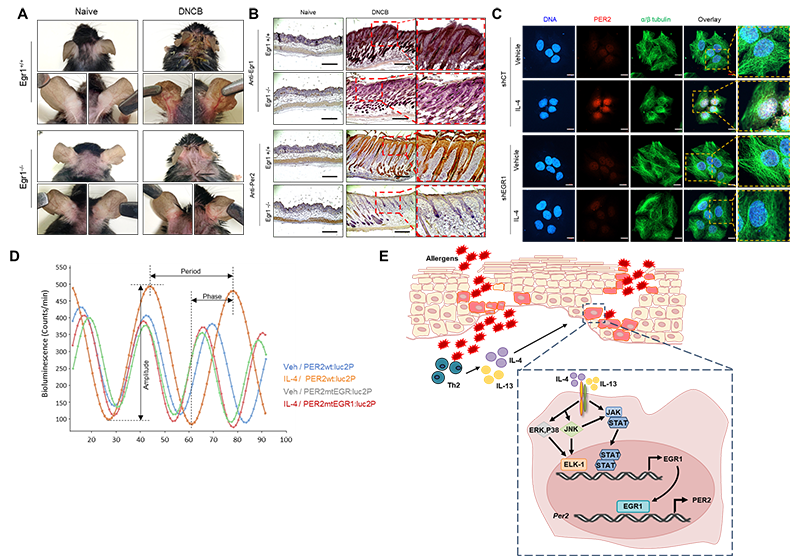- 글번호
- 949875
Prof. Soon Young Shin’s Team Identifies a Cause of Circadian Rhythm Disorder in Atopic Dermatitis
- Writer
- 관리자
- View
- 2979
- Date
- 2022.04.19
- 수정일
- 2022.04.19
A research team of Prof. Soon Young Shin from College of Sanghuh Life Science at Konkuk University (Department of Biological Sciences) announced on the 18th that they have identified the molecular biological principle of disturbing the expression of the PER2 biological clock gene, which regulates circadian biorhythm in atopic dermatitis.
Atopic dermatitis is a representative inflammatory skin disease accompanied by severely painful itching. It occurs mainly in infants and toddlers, but it is considered a chronic intractable disease since it continues throughout the life of the young and the elderly causing allergic diseases such as asthma and rheumatoid arthritis.
As all life on Earth is synchronized with changes in the environment during the day and night, various biochemical, physiological and behavioral reactions including sleep, hormone secretion and metabolism appear every 24 hours. This phenomenon is called a circadian rhythm. The circadian rhythm is controlled by an expression feedback loop of biological clock genes such as CLOCK, BMAL1, PER1/2, CRY and etc. Among them, PER2 is considered to be a core factor that controls skin circadian rhythm.
It is known that sleep disorders, hormone secretion disorders, inflammatory reactions and itching are severely shown as a circadian rhythm of an atopic dermatitis patient changes. However, there is little to no information on what molecular reactions cause circadian rhythm disorder for atopic dermatitis.
Throughout the previous research, Prof. Soon Young Shin’s team discovered that EGR1 is a key regulator that deteriorates atopic dermatitis by producing various types of inflammatory cytokines. The team found out the molecular biological principle of disturbing the circadian rhythm by increasing the production of PER2, the core biological clock gene that regulates circadian rhythm in skin cells where atopic dermatitis occurs.
The cytokines secreted by the type 2 helper T-lymphocyte are immune proteins that play a significant role in active immune responses. Among them, IL-4 is a cytokine that shows a pivotal role in worsening the beginning stage of atopic dermatitis and symptoms. With EGR1 knockout mouse, the research team identified that IL-4 produced in an atopic dermatitis environment increases the EGR1 gene expression of keratinocytes, and accumulated EGR1 binds to a PER2 gene promoter to stimulate PER2 gene expression, resulting in circadian rhythm disorder in inflammatory skin.
Prof. Shin, the lead researcher said, “The circadian rhythm is seriously disturbed in atopic dermatitis causing not only sleep disorders but suppression of immune system, itching and etc,” and, “Currently supported by the Korea Drug Development Project, we are conducting research on atopic dermatitis treatments that selectively target EGR1, the transcription factors.”
In addition, she said, “Throughout the project, EGR1 can be used as a candidate substance for a new concept of target treatment that can restore disturbed skin circadian rhythm, enhance effectiveness and control the production of various inflammatory cytokines produced in atopic skin.”
The research was conducted with the support of the ‘Korea Drug Development Project’ by the Korea Drug Development Fund (CEO Muk, Hyunsang) and Hyunjin Yeo, a student of combined MS/Ph.D. student participated as the lead author with the sponsor of ‘Basic Research in Science & Engineering’ by the National Research Foundation of Korea. The research results were published online on April 7th in the Journal of Investigative Dermatology (2020 Citation Index: 8.5513), the top 3.3% international academic journal in dermatology.